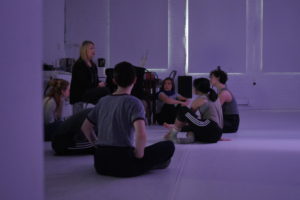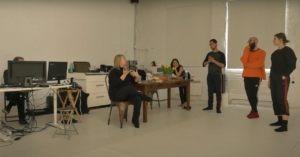Workshops – Dancers
During these five-day workshops, artists were able to develop new performance skills by probing the technological and choreographic mysteries of Van Grimde Corps Secrets. They discovered the company’s exclusive techniques and gestural territories, and got the chance to play with the avant-garde interactive devices of Eve 2050: The Installation. Using tracking technologies (infrared camera, Kinect, custom-designed computer algorithms, etc.), they learned how to modulate their movements and displacements in real time in a sensitive interactive environment. Veritable extensions of the body, or virtual prostheses, these devices allowed them to transform space, generate visual and sound effects, and interact with others in unusual ways. Choreographer Isabelle Van Grimde, performer Sophie Breton, composer Thom Gossage, and the team of audio-visual programmers/designers at Van Grimde Corps Secrets served as guides in the exploration of this remarkable universe.

5 discoveries made by the dancers
1. The technologies explored serve as extensions of the human body and seem to amplify its movements.
2. The importance of managing interaction with the technology in the same way one manages interaction with another dancer.
3. A new sensitivity has to be learned in order to be detected and “read” by the machine.
4. The importance of learning how to manage unexpected technological occurrences.
5. The importance of learning how to integrate technology without losing the connection with one’s body. Learning how to do several things at once.

Workshops – Choreographers
These workshops allowed participants to explore interactive technologies designed for dance from the choreographer’s point of view. The tools employed, which have considerable poetic potential, can enrich the gestural language, question the choreographic concepts, and foster new skills or compositional affinities. By opening up a space for exploration, experimentation and reflection on choreographic composition and creation using interactive digital technologies, the goal was to evaluate the extent to which these new tools can be inspiring and supportive in diverse choreographic practices. Participants were guided in a hand’s-on use of these tools. The technologies explored were those typically used by Van Grimde Corps Secrets, which are well suited to dance since they impose no constraints on the body: the dancers do not wear sensors, the body is totally free. The choreographers were given the opportunity to play with the technologies used in the creation of the Eve 2050 triptych and Symphony 5.1: tracking technologies (infrared camera, Kinect), modular opaque screens, motion-based sound creation systems, custom-designed computer algorithms for movement processing, etc. The instructors’ mission was to make choreographers think and feel differently about space and movement, to generate visual and sound effects, and to establish unusual relationships between bodies, between the organic and the inorganic, between performers and potential spectators.

3 discoveries made by the choreographers
1. Working with these technologies requires a great deal of lucidity to keep on track, and also requires preserving the principal medium: the body and, by extension, dance.
2. Transdisciplinary work requires a large team of collaborators. As a choreographer, therefore, you must keep your focus on your own ideas while incorporating promising elements from collaborators.
3. Much laboratory time needs to be scheduled to develop and test out the various technologies.

